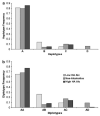Association of galanin haplotypes with alcoholism and anxiety in two ethnically distinct populations
- PMID: 16314872
- PMCID: PMC2748409
- DOI: 10.1038/sj.mp.4001768
Association of galanin haplotypes with alcoholism and anxiety in two ethnically distinct populations
Abstract
The neuropeptide galanin (GAL) is widely expressed in the central nervous system. Animal studies have implicated GAL in alcohol abuse and anxiety: chronic ethanol intake increases hypothalamic GAL mRNA; high levels of stress increase GAL release in the central amygdala. The coding sequence of the galanin gene, GAL, is highly conserved and a functional polymorphism has not yet been found. The aim of our study was, for the first time, to identify GAL haplotypes and investigate associations with alcoholism and anxiety. Seven single-nucleotide polymorphisms (SNPs) spanning GAL were genotyped in 65 controls from five populations: US and Finnish Caucasians, African Americans, Plains and Southwestern Indians. A single haplotype block with little evidence of historical recombination was observed for each population. Four tag SNPs were then genotyped in DSM-III-R lifetime alcoholics and nonalcoholics from two population isolates: 514 Finnish Caucasian men and 331 Plains Indian men and women. Tridimensional Personality Questionnaire harm avoidance (HA) scores, a dimensional measure of anxiety, were obtained. There was a haplotype association with alcoholism in both the Finnish (P=0.001) and Plains Indian (P=0.004) men. The SNPs were also significantly associated. Alcoholics were divided into high and low HA groups (>or= and <mean HA of population). In the Finns, haplotype (P<0.0001) and diplotype (P<0.0001) distributions differed between high HA alcoholics, low HA alcoholics and nonalcoholics. Our results from two independent populations suggest that GAL may contribute to vulnerability to alcoholism, perhaps mediated by dimensional anxiety.
Figures




References
-
- Jacobowitz DM, Kresse A, Skofitsch G. Galanin in the brain: chemoarchitectonics and brain cartography — a historical review. Peptides. 2004;25:433–464. - PubMed
-
- Wrenn CC, Crawley JN. Pharmacological evidence supporting a role for galanin in cognition and affect. Prog Neuropsychopharmacol Biol Psychiatry. 2001;25:283–299. - PubMed
-
- Crawley JN. Biological actions of galanin. Regul Pept. 1995;59:1–16. - PubMed
-
- Hokfelt T, Broberger C, Diez M, Xu ZQ, Shi T, Kopp J, et al. Galanin and NPY, two peptides with multiple putative roles in the nervous system. Horm Metab Res. 1999;31:330–334. - PubMed
Publication types
MeSH terms
Substances
Grants and funding
LinkOut - more resources
Full Text Sources
Medical

